- A 13th century Krakowian fable tells the tale of a bugle player protecting the city from an imminent Mongol attack. Legend claims that the bugler was shot as he sounded the alarm, his heart pierced with an arrow and his warning cut short. This warning call, a five-note phrase know as the hejnal mariacki, is now played once an hour from the twin steeples of St. Mary's Basilica on Krakow's main square, a sharp reminder of the city's history of suffering and survival. Having endured attacks by Teutonic Knights, Russians, Swedes, Austrians, Nazis and communists, the apocalyptic notion of the end has haunted Krakow throughout the course of history.
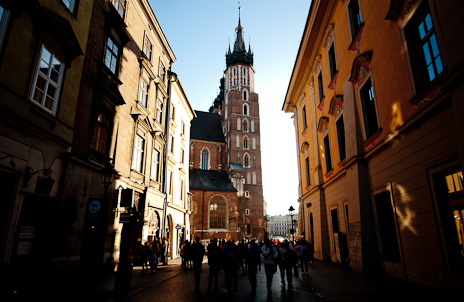 Photo credit: Camille Blake
It was this idea of apocalyptic ending that was explored throughout the tenth edition of Krakow's weeklong Unsound Festival. Inspired in part by the 2012-doomsday theories, in part by the deathly atmosphere of a wide range of music released in 2012, the festival's title "The End" also aimed to discuss the human ability to design technology in order to bring about our own extinction.
With fall descending on the city of Krakow and the smoggy orange glow of mid-autumnal sun engulfing a picturesque medieval Old Town, those arriving in the city were ironically greeted by decidedly un-apocalyptic weather conditions. The majority of festival proceedings took place inside the leafy boundaries of the Old Town and the historic Jewish quarter of Kazimierz, with numerous events held in city landmarks: Tim Hecker and Daniel Lopatin performed from the towering chancel of St. Katharine's Church; Demdike Stare in the shadow of the Tempel Synagogue's exquisite gold leaf-adorned Aron Kodesh. Given the allure of Krakow's narrow cobbled streets, the gothic appeal of the Wawel complex on the banks of the Vistula River—and also taking into account the length of the festival—it is easy to see why so many visitors develop such a strong connection to the city, with a number of festival goers and artists alike returning in 2012 for their annual Unsound pilgrimage.
The jazz basements for which Krakow is famous did not go unnoticed—nor, thankfully, did Polish music. Most events at Unsound were opened by Polish artists or featured some sort of Polish cultural influence, be it Andy Votel's sinister audio-visual adaptation of the Polish children's Pan Kleks movie trilogy, or Julia Holter and Demdike Stare's respective performances with the Sinfonia Iuventus Quartet and the Sinfonietta Cracovia. Mazzoll, a Zappa-esque figure of the Polish Yass movement, provided one of the festival highlights in the cave-like dungeon of Klub RE with his hypnotic blend of jazz and live electronics. Festival head Mat Schulz recreated the homely vibe of an intimate communist-era Krakow apartment party with his Bambino Sound System project, and virtuoso Polish percussionist Hubert Zemler made multiple appearances throughout the week—most notably soundtracking the 1930s experimental films of Stefan and Franciszka Themerson as part of Sza/Za/Ze—but also as a solo performer in the upstairs bar of the Muzeum Manggha with the ghostly shadow of the Wawel castle as his backdrop.
Photo credit: Camille Blake
It was this idea of apocalyptic ending that was explored throughout the tenth edition of Krakow's weeklong Unsound Festival. Inspired in part by the 2012-doomsday theories, in part by the deathly atmosphere of a wide range of music released in 2012, the festival's title "The End" also aimed to discuss the human ability to design technology in order to bring about our own extinction.
With fall descending on the city of Krakow and the smoggy orange glow of mid-autumnal sun engulfing a picturesque medieval Old Town, those arriving in the city were ironically greeted by decidedly un-apocalyptic weather conditions. The majority of festival proceedings took place inside the leafy boundaries of the Old Town and the historic Jewish quarter of Kazimierz, with numerous events held in city landmarks: Tim Hecker and Daniel Lopatin performed from the towering chancel of St. Katharine's Church; Demdike Stare in the shadow of the Tempel Synagogue's exquisite gold leaf-adorned Aron Kodesh. Given the allure of Krakow's narrow cobbled streets, the gothic appeal of the Wawel complex on the banks of the Vistula River—and also taking into account the length of the festival—it is easy to see why so many visitors develop such a strong connection to the city, with a number of festival goers and artists alike returning in 2012 for their annual Unsound pilgrimage.
The jazz basements for which Krakow is famous did not go unnoticed—nor, thankfully, did Polish music. Most events at Unsound were opened by Polish artists or featured some sort of Polish cultural influence, be it Andy Votel's sinister audio-visual adaptation of the Polish children's Pan Kleks movie trilogy, or Julia Holter and Demdike Stare's respective performances with the Sinfonia Iuventus Quartet and the Sinfonietta Cracovia. Mazzoll, a Zappa-esque figure of the Polish Yass movement, provided one of the festival highlights in the cave-like dungeon of Klub RE with his hypnotic blend of jazz and live electronics. Festival head Mat Schulz recreated the homely vibe of an intimate communist-era Krakow apartment party with his Bambino Sound System project, and virtuoso Polish percussionist Hubert Zemler made multiple appearances throughout the week—most notably soundtracking the 1930s experimental films of Stefan and Franciszka Themerson as part of Sza/Za/Ze—but also as a solo performer in the upstairs bar of the Muzeum Manggha with the ghostly shadow of the Wawel castle as his backdrop.
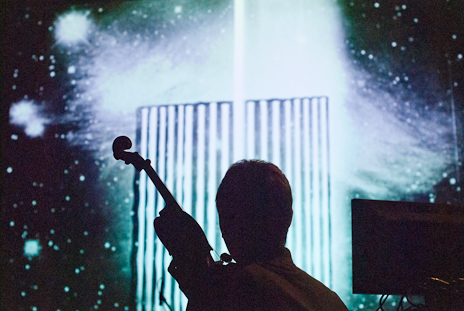 Photo credit: Camille Blake
Situated on the southern bank of the Vistula, the sleek Manggha Museum of Japanese Art and Technology functioned as somewhat of a meeting point throughout the festival. The flexibility of the main room, with its rich wooden paneling and brutally clear soundsystem, allowed it to operate as both sit-down ambient listening room and standard club space. Accordingly, the highlighted performances ranged from Japanese noise legend Keiji Haino to LA's Vatican Shadow, and new Raster-Noton signees Emptyset to voice experimentalist Holly Herndon. Those who remained at the Manggha after Vessel's striking live set on Saturday afternoon were treated to Wife's debut—a serene display of melodic groove and vocal talent, demonstrating his potential as both live performer and producer.
Somewhat of an Unsound Festival staple, V/Vm's James Leyland Kirby, AKA The Caretaker, was carried onto the stage this year in a coffin to Gustav Holst's "I Vow to Thee, My Country" and footage of Winston Churchill's state funeral playing in the background. Quickly beginning a set of noise-driven psycho karaoke covers, the performance featured appearances from a toilet paper-bandaged zombie Michael Jackson, a semi-naked bunny rabbit, various pigs, vast amounts of crowd surfing, air guitar action and whisky-fuelled destructive madness. Launched onto a somewhat unsuspecting audience who were trapped in their seats at the Kijow Centrum Cinema, from the first explosion of sound Kirby divided the Unsound crowd into two groups: those that now loved V/Vm, and those that hated them. While their attempts to inject kinetic humor into the largely somber and cerebral world of experimental music is commendable, one has to question the artistic merit in what was actually presented: Was it genius, or was it simply a Mancunian regurgitation of the antics seen on MTV's Jackass? As Stefan Betke, AKA Pole, was keen to point out in a midweek panel discussion where he confronted Kirby, the issues don't necessarily lie in the philosophy behind the pranks, but in the quality of their execution. One thing is clear: V/Vm were an obvious highlight of the festival, even if their show's sole merit was its ability to spark debate.
Photo credit: Camille Blake
Situated on the southern bank of the Vistula, the sleek Manggha Museum of Japanese Art and Technology functioned as somewhat of a meeting point throughout the festival. The flexibility of the main room, with its rich wooden paneling and brutally clear soundsystem, allowed it to operate as both sit-down ambient listening room and standard club space. Accordingly, the highlighted performances ranged from Japanese noise legend Keiji Haino to LA's Vatican Shadow, and new Raster-Noton signees Emptyset to voice experimentalist Holly Herndon. Those who remained at the Manggha after Vessel's striking live set on Saturday afternoon were treated to Wife's debut—a serene display of melodic groove and vocal talent, demonstrating his potential as both live performer and producer.
Somewhat of an Unsound Festival staple, V/Vm's James Leyland Kirby, AKA The Caretaker, was carried onto the stage this year in a coffin to Gustav Holst's "I Vow to Thee, My Country" and footage of Winston Churchill's state funeral playing in the background. Quickly beginning a set of noise-driven psycho karaoke covers, the performance featured appearances from a toilet paper-bandaged zombie Michael Jackson, a semi-naked bunny rabbit, various pigs, vast amounts of crowd surfing, air guitar action and whisky-fuelled destructive madness. Launched onto a somewhat unsuspecting audience who were trapped in their seats at the Kijow Centrum Cinema, from the first explosion of sound Kirby divided the Unsound crowd into two groups: those that now loved V/Vm, and those that hated them. While their attempts to inject kinetic humor into the largely somber and cerebral world of experimental music is commendable, one has to question the artistic merit in what was actually presented: Was it genius, or was it simply a Mancunian regurgitation of the antics seen on MTV's Jackass? As Stefan Betke, AKA Pole, was keen to point out in a midweek panel discussion where he confronted Kirby, the issues don't necessarily lie in the philosophy behind the pranks, but in the quality of their execution. One thing is clear: V/Vm were an obvious highlight of the festival, even if their show's sole merit was its ability to spark debate.
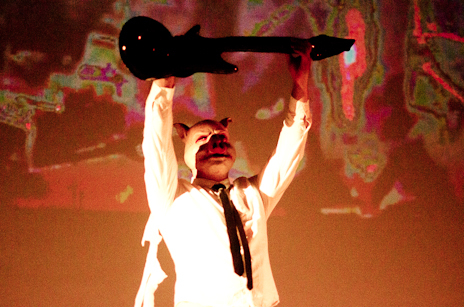 Photo credit: Camille Blake
In sharp contrast to V/Vm's performance, there was little debate regarding the quality of aTelecine's lackluster world debut. The looped whispers, pastoral backgrounds, and references to Bunuel's Un Chien Andalou came across as being decidedly art school, and whatever role Lustmord played in the development of their live show remains unclear, given his generally meticulous attention to sonic detail which was exhibited in the standout live performance with Biosphere the previous night. aTelecine's performance was further weakened by the fact that it was sandwiched conspicuously between two striking performances from Ben Frost and Raime, the former debuting an ear-shatteringly powerful show featuring the percussive duo of Greg Fox and Shahzad Ismaily, the latter a harrowing audio-visual exploration of frequency and the human form.
Photo credit: Camille Blake
In sharp contrast to V/Vm's performance, there was little debate regarding the quality of aTelecine's lackluster world debut. The looped whispers, pastoral backgrounds, and references to Bunuel's Un Chien Andalou came across as being decidedly art school, and whatever role Lustmord played in the development of their live show remains unclear, given his generally meticulous attention to sonic detail which was exhibited in the standout live performance with Biosphere the previous night. aTelecine's performance was further weakened by the fact that it was sandwiched conspicuously between two striking performances from Ben Frost and Raime, the former debuting an ear-shatteringly powerful show featuring the percussive duo of Greg Fox and Shahzad Ismaily, the latter a harrowing audio-visual exploration of frequency and the human form.
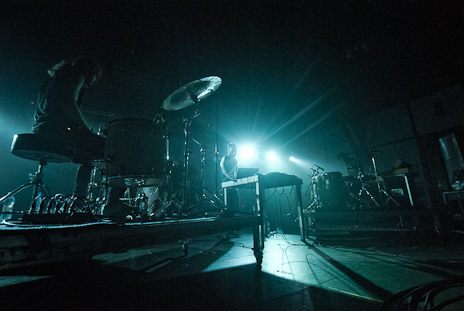 Photo credit: Camille Blake
With a noticeable increase in attendance for the weekend portion of the festival, Friday and Saturday's evening events were held at the abandoned Hotel Forum, a looming bastion of communist-era architecture situated further East down the river from the Manggha. With its north-facing facade masked by a giant billboard advertising Skyn condoms, the Paradise strip club housed in the basement and rumors surrounding the political corruption that has caused the building to remain empty for over a decade, the Forum is haunted both by the ghosts of the past and the sleazy neglect of its present state. This sense of indifference, coupled with the venue's gloomy carpeted hallways and the thick nocturnal fog that appeared to have swallowed the building, only added to the aura of Kubrick-esque magic. There was something both peculiar and endearing about dancing to the sounds of MikeQ and Theo Parrish in an eerie, abandoned ballroom surrounded by gyrating Krakowian teens while the overpowering odor of potatoes crept in from the nearby cafeteria.
Photo credit: Camille Blake
With a noticeable increase in attendance for the weekend portion of the festival, Friday and Saturday's evening events were held at the abandoned Hotel Forum, a looming bastion of communist-era architecture situated further East down the river from the Manggha. With its north-facing facade masked by a giant billboard advertising Skyn condoms, the Paradise strip club housed in the basement and rumors surrounding the political corruption that has caused the building to remain empty for over a decade, the Forum is haunted both by the ghosts of the past and the sleazy neglect of its present state. This sense of indifference, coupled with the venue's gloomy carpeted hallways and the thick nocturnal fog that appeared to have swallowed the building, only added to the aura of Kubrick-esque magic. There was something both peculiar and endearing about dancing to the sounds of MikeQ and Theo Parrish in an eerie, abandoned ballroom surrounded by gyrating Krakowian teens while the overpowering odor of potatoes crept in from the nearby cafeteria.
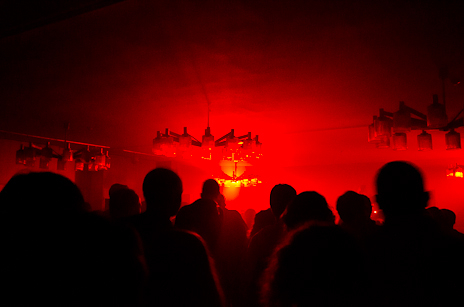 Photo credit: Camille Blake
Monolake and Christopher Bauder wound down the ninth and final day of the festival with two performances of their Atom installation at the Laznia Nowa Theatre, a spacious venue located twenty minutes outside of the city in the suburb of Nowa Huta, once the heart of the Polish Solidarity movement. Those who had made the journey were clearly pleased to be given the opportunity to lie down and gaze up at the installation's 64 motion-controlled balloons, immersing themselves in Henke's soporific soundtrack. While the finale of Demdike Stare's closing concert demonstrated the similarities between a vivacious concert conductor and a locked-in MIDI clock (and the harsh reality that they don't often function in tandem), it nevertheless remained a strong performance, primarily as a result of Danny Norbury's exquisite string arrangements. Those still standing for the final hurrah at Klub Pauza were rewarded with a sublime performance from Pan Record's NHK'Koyxen, and by the time Hieroglyphic Being dropped his early morning festival closer—Basia's 1987 hit "Promises"—with its verse proclaiming that the "here and now is all that it's about," any notion of apocalyptic doom that may have been present over the course of the previous week had effectively been washed away.
Photo credit: Camille Blake
Monolake and Christopher Bauder wound down the ninth and final day of the festival with two performances of their Atom installation at the Laznia Nowa Theatre, a spacious venue located twenty minutes outside of the city in the suburb of Nowa Huta, once the heart of the Polish Solidarity movement. Those who had made the journey were clearly pleased to be given the opportunity to lie down and gaze up at the installation's 64 motion-controlled balloons, immersing themselves in Henke's soporific soundtrack. While the finale of Demdike Stare's closing concert demonstrated the similarities between a vivacious concert conductor and a locked-in MIDI clock (and the harsh reality that they don't often function in tandem), it nevertheless remained a strong performance, primarily as a result of Danny Norbury's exquisite string arrangements. Those still standing for the final hurrah at Klub Pauza were rewarded with a sublime performance from Pan Record's NHK'Koyxen, and by the time Hieroglyphic Being dropped his early morning festival closer—Basia's 1987 hit "Promises"—with its verse proclaiming that the "here and now is all that it's about," any notion of apocalyptic doom that may have been present over the course of the previous week had effectively been washed away.
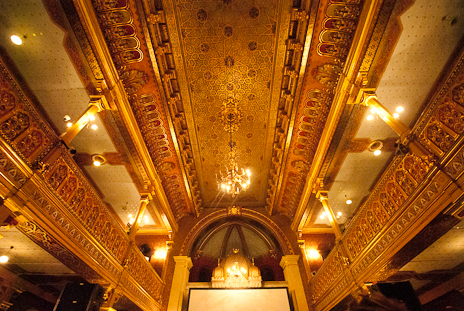 Photo credit: Camille Blake
On Monday morning, while the festival office on Ul. Florianska was being dismantled and taxis were being called to shuttle attendees to the airport, a number of those still in Krakow took the time to visit the Wawel Castle and stroll along the sun-drenched banks of the Vistula, gazes drifting off towards the perpetually suspended hot air balloon that punctuates the southern Krakowian skyline. Some headed to the nearby countryside in an attempt to continue the party, but also to undoubtedly take the time to process the overload of sound, sight and information that had been acquired over the course of the nine day experience. Much like the tune of the hejnal mariacki, Unsound 2012 had come to an abrupt halt. While the future of the festival remains to be determined, those who were in attendance can rest assured that—like the haunted melodies that repeatedly emerge from St. Mary's Basilica—even in the face of the apocalypse, Unsound is a symbolic and highly relevant reminder of the true power of Krakowian cultural endurance.
Photo credit: Camille Blake
On Monday morning, while the festival office on Ul. Florianska was being dismantled and taxis were being called to shuttle attendees to the airport, a number of those still in Krakow took the time to visit the Wawel Castle and stroll along the sun-drenched banks of the Vistula, gazes drifting off towards the perpetually suspended hot air balloon that punctuates the southern Krakowian skyline. Some headed to the nearby countryside in an attempt to continue the party, but also to undoubtedly take the time to process the overload of sound, sight and information that had been acquired over the course of the nine day experience. Much like the tune of the hejnal mariacki, Unsound 2012 had come to an abrupt halt. While the future of the festival remains to be determined, those who were in attendance can rest assured that—like the haunted melodies that repeatedly emerge from St. Mary's Basilica—even in the face of the apocalypse, Unsound is a symbolic and highly relevant reminder of the true power of Krakowian cultural endurance.
 Photo credit: Camille Blake
It was this idea of apocalyptic ending that was explored throughout the tenth edition of Krakow's weeklong Unsound Festival. Inspired in part by the 2012-doomsday theories, in part by the deathly atmosphere of a wide range of music released in 2012, the festival's title "The End" also aimed to discuss the human ability to design technology in order to bring about our own extinction.
With fall descending on the city of Krakow and the smoggy orange glow of mid-autumnal sun engulfing a picturesque medieval Old Town, those arriving in the city were ironically greeted by decidedly un-apocalyptic weather conditions. The majority of festival proceedings took place inside the leafy boundaries of the Old Town and the historic Jewish quarter of Kazimierz, with numerous events held in city landmarks: Tim Hecker and Daniel Lopatin performed from the towering chancel of St. Katharine's Church; Demdike Stare in the shadow of the Tempel Synagogue's exquisite gold leaf-adorned Aron Kodesh. Given the allure of Krakow's narrow cobbled streets, the gothic appeal of the Wawel complex on the banks of the Vistula River—and also taking into account the length of the festival—it is easy to see why so many visitors develop such a strong connection to the city, with a number of festival goers and artists alike returning in 2012 for their annual Unsound pilgrimage.
The jazz basements for which Krakow is famous did not go unnoticed—nor, thankfully, did Polish music. Most events at Unsound were opened by Polish artists or featured some sort of Polish cultural influence, be it Andy Votel's sinister audio-visual adaptation of the Polish children's Pan Kleks movie trilogy, or Julia Holter and Demdike Stare's respective performances with the Sinfonia Iuventus Quartet and the Sinfonietta Cracovia. Mazzoll, a Zappa-esque figure of the Polish Yass movement, provided one of the festival highlights in the cave-like dungeon of Klub RE with his hypnotic blend of jazz and live electronics. Festival head Mat Schulz recreated the homely vibe of an intimate communist-era Krakow apartment party with his Bambino Sound System project, and virtuoso Polish percussionist Hubert Zemler made multiple appearances throughout the week—most notably soundtracking the 1930s experimental films of Stefan and Franciszka Themerson as part of Sza/Za/Ze—but also as a solo performer in the upstairs bar of the Muzeum Manggha with the ghostly shadow of the Wawel castle as his backdrop.
Photo credit: Camille Blake
It was this idea of apocalyptic ending that was explored throughout the tenth edition of Krakow's weeklong Unsound Festival. Inspired in part by the 2012-doomsday theories, in part by the deathly atmosphere of a wide range of music released in 2012, the festival's title "The End" also aimed to discuss the human ability to design technology in order to bring about our own extinction.
With fall descending on the city of Krakow and the smoggy orange glow of mid-autumnal sun engulfing a picturesque medieval Old Town, those arriving in the city were ironically greeted by decidedly un-apocalyptic weather conditions. The majority of festival proceedings took place inside the leafy boundaries of the Old Town and the historic Jewish quarter of Kazimierz, with numerous events held in city landmarks: Tim Hecker and Daniel Lopatin performed from the towering chancel of St. Katharine's Church; Demdike Stare in the shadow of the Tempel Synagogue's exquisite gold leaf-adorned Aron Kodesh. Given the allure of Krakow's narrow cobbled streets, the gothic appeal of the Wawel complex on the banks of the Vistula River—and also taking into account the length of the festival—it is easy to see why so many visitors develop such a strong connection to the city, with a number of festival goers and artists alike returning in 2012 for their annual Unsound pilgrimage.
The jazz basements for which Krakow is famous did not go unnoticed—nor, thankfully, did Polish music. Most events at Unsound were opened by Polish artists or featured some sort of Polish cultural influence, be it Andy Votel's sinister audio-visual adaptation of the Polish children's Pan Kleks movie trilogy, or Julia Holter and Demdike Stare's respective performances with the Sinfonia Iuventus Quartet and the Sinfonietta Cracovia. Mazzoll, a Zappa-esque figure of the Polish Yass movement, provided one of the festival highlights in the cave-like dungeon of Klub RE with his hypnotic blend of jazz and live electronics. Festival head Mat Schulz recreated the homely vibe of an intimate communist-era Krakow apartment party with his Bambino Sound System project, and virtuoso Polish percussionist Hubert Zemler made multiple appearances throughout the week—most notably soundtracking the 1930s experimental films of Stefan and Franciszka Themerson as part of Sza/Za/Ze—but also as a solo performer in the upstairs bar of the Muzeum Manggha with the ghostly shadow of the Wawel castle as his backdrop.
 Photo credit: Camille Blake
Situated on the southern bank of the Vistula, the sleek Manggha Museum of Japanese Art and Technology functioned as somewhat of a meeting point throughout the festival. The flexibility of the main room, with its rich wooden paneling and brutally clear soundsystem, allowed it to operate as both sit-down ambient listening room and standard club space. Accordingly, the highlighted performances ranged from Japanese noise legend Keiji Haino to LA's Vatican Shadow, and new Raster-Noton signees Emptyset to voice experimentalist Holly Herndon. Those who remained at the Manggha after Vessel's striking live set on Saturday afternoon were treated to Wife's debut—a serene display of melodic groove and vocal talent, demonstrating his potential as both live performer and producer.
Somewhat of an Unsound Festival staple, V/Vm's James Leyland Kirby, AKA The Caretaker, was carried onto the stage this year in a coffin to Gustav Holst's "I Vow to Thee, My Country" and footage of Winston Churchill's state funeral playing in the background. Quickly beginning a set of noise-driven psycho karaoke covers, the performance featured appearances from a toilet paper-bandaged zombie Michael Jackson, a semi-naked bunny rabbit, various pigs, vast amounts of crowd surfing, air guitar action and whisky-fuelled destructive madness. Launched onto a somewhat unsuspecting audience who were trapped in their seats at the Kijow Centrum Cinema, from the first explosion of sound Kirby divided the Unsound crowd into two groups: those that now loved V/Vm, and those that hated them. While their attempts to inject kinetic humor into the largely somber and cerebral world of experimental music is commendable, one has to question the artistic merit in what was actually presented: Was it genius, or was it simply a Mancunian regurgitation of the antics seen on MTV's Jackass? As Stefan Betke, AKA Pole, was keen to point out in a midweek panel discussion where he confronted Kirby, the issues don't necessarily lie in the philosophy behind the pranks, but in the quality of their execution. One thing is clear: V/Vm were an obvious highlight of the festival, even if their show's sole merit was its ability to spark debate.
Photo credit: Camille Blake
Situated on the southern bank of the Vistula, the sleek Manggha Museum of Japanese Art and Technology functioned as somewhat of a meeting point throughout the festival. The flexibility of the main room, with its rich wooden paneling and brutally clear soundsystem, allowed it to operate as both sit-down ambient listening room and standard club space. Accordingly, the highlighted performances ranged from Japanese noise legend Keiji Haino to LA's Vatican Shadow, and new Raster-Noton signees Emptyset to voice experimentalist Holly Herndon. Those who remained at the Manggha after Vessel's striking live set on Saturday afternoon were treated to Wife's debut—a serene display of melodic groove and vocal talent, demonstrating his potential as both live performer and producer.
Somewhat of an Unsound Festival staple, V/Vm's James Leyland Kirby, AKA The Caretaker, was carried onto the stage this year in a coffin to Gustav Holst's "I Vow to Thee, My Country" and footage of Winston Churchill's state funeral playing in the background. Quickly beginning a set of noise-driven psycho karaoke covers, the performance featured appearances from a toilet paper-bandaged zombie Michael Jackson, a semi-naked bunny rabbit, various pigs, vast amounts of crowd surfing, air guitar action and whisky-fuelled destructive madness. Launched onto a somewhat unsuspecting audience who were trapped in their seats at the Kijow Centrum Cinema, from the first explosion of sound Kirby divided the Unsound crowd into two groups: those that now loved V/Vm, and those that hated them. While their attempts to inject kinetic humor into the largely somber and cerebral world of experimental music is commendable, one has to question the artistic merit in what was actually presented: Was it genius, or was it simply a Mancunian regurgitation of the antics seen on MTV's Jackass? As Stefan Betke, AKA Pole, was keen to point out in a midweek panel discussion where he confronted Kirby, the issues don't necessarily lie in the philosophy behind the pranks, but in the quality of their execution. One thing is clear: V/Vm were an obvious highlight of the festival, even if their show's sole merit was its ability to spark debate.
 Photo credit: Camille Blake
In sharp contrast to V/Vm's performance, there was little debate regarding the quality of aTelecine's lackluster world debut. The looped whispers, pastoral backgrounds, and references to Bunuel's Un Chien Andalou came across as being decidedly art school, and whatever role Lustmord played in the development of their live show remains unclear, given his generally meticulous attention to sonic detail which was exhibited in the standout live performance with Biosphere the previous night. aTelecine's performance was further weakened by the fact that it was sandwiched conspicuously between two striking performances from Ben Frost and Raime, the former debuting an ear-shatteringly powerful show featuring the percussive duo of Greg Fox and Shahzad Ismaily, the latter a harrowing audio-visual exploration of frequency and the human form.
Photo credit: Camille Blake
In sharp contrast to V/Vm's performance, there was little debate regarding the quality of aTelecine's lackluster world debut. The looped whispers, pastoral backgrounds, and references to Bunuel's Un Chien Andalou came across as being decidedly art school, and whatever role Lustmord played in the development of their live show remains unclear, given his generally meticulous attention to sonic detail which was exhibited in the standout live performance with Biosphere the previous night. aTelecine's performance was further weakened by the fact that it was sandwiched conspicuously between two striking performances from Ben Frost and Raime, the former debuting an ear-shatteringly powerful show featuring the percussive duo of Greg Fox and Shahzad Ismaily, the latter a harrowing audio-visual exploration of frequency and the human form.
 Photo credit: Camille Blake
With a noticeable increase in attendance for the weekend portion of the festival, Friday and Saturday's evening events were held at the abandoned Hotel Forum, a looming bastion of communist-era architecture situated further East down the river from the Manggha. With its north-facing facade masked by a giant billboard advertising Skyn condoms, the Paradise strip club housed in the basement and rumors surrounding the political corruption that has caused the building to remain empty for over a decade, the Forum is haunted both by the ghosts of the past and the sleazy neglect of its present state. This sense of indifference, coupled with the venue's gloomy carpeted hallways and the thick nocturnal fog that appeared to have swallowed the building, only added to the aura of Kubrick-esque magic. There was something both peculiar and endearing about dancing to the sounds of MikeQ and Theo Parrish in an eerie, abandoned ballroom surrounded by gyrating Krakowian teens while the overpowering odor of potatoes crept in from the nearby cafeteria.
Photo credit: Camille Blake
With a noticeable increase in attendance for the weekend portion of the festival, Friday and Saturday's evening events were held at the abandoned Hotel Forum, a looming bastion of communist-era architecture situated further East down the river from the Manggha. With its north-facing facade masked by a giant billboard advertising Skyn condoms, the Paradise strip club housed in the basement and rumors surrounding the political corruption that has caused the building to remain empty for over a decade, the Forum is haunted both by the ghosts of the past and the sleazy neglect of its present state. This sense of indifference, coupled with the venue's gloomy carpeted hallways and the thick nocturnal fog that appeared to have swallowed the building, only added to the aura of Kubrick-esque magic. There was something both peculiar and endearing about dancing to the sounds of MikeQ and Theo Parrish in an eerie, abandoned ballroom surrounded by gyrating Krakowian teens while the overpowering odor of potatoes crept in from the nearby cafeteria.
 Photo credit: Camille Blake
Monolake and Christopher Bauder wound down the ninth and final day of the festival with two performances of their Atom installation at the Laznia Nowa Theatre, a spacious venue located twenty minutes outside of the city in the suburb of Nowa Huta, once the heart of the Polish Solidarity movement. Those who had made the journey were clearly pleased to be given the opportunity to lie down and gaze up at the installation's 64 motion-controlled balloons, immersing themselves in Henke's soporific soundtrack. While the finale of Demdike Stare's closing concert demonstrated the similarities between a vivacious concert conductor and a locked-in MIDI clock (and the harsh reality that they don't often function in tandem), it nevertheless remained a strong performance, primarily as a result of Danny Norbury's exquisite string arrangements. Those still standing for the final hurrah at Klub Pauza were rewarded with a sublime performance from Pan Record's NHK'Koyxen, and by the time Hieroglyphic Being dropped his early morning festival closer—Basia's 1987 hit "Promises"—with its verse proclaiming that the "here and now is all that it's about," any notion of apocalyptic doom that may have been present over the course of the previous week had effectively been washed away.
Photo credit: Camille Blake
Monolake and Christopher Bauder wound down the ninth and final day of the festival with two performances of their Atom installation at the Laznia Nowa Theatre, a spacious venue located twenty minutes outside of the city in the suburb of Nowa Huta, once the heart of the Polish Solidarity movement. Those who had made the journey were clearly pleased to be given the opportunity to lie down and gaze up at the installation's 64 motion-controlled balloons, immersing themselves in Henke's soporific soundtrack. While the finale of Demdike Stare's closing concert demonstrated the similarities between a vivacious concert conductor and a locked-in MIDI clock (and the harsh reality that they don't often function in tandem), it nevertheless remained a strong performance, primarily as a result of Danny Norbury's exquisite string arrangements. Those still standing for the final hurrah at Klub Pauza were rewarded with a sublime performance from Pan Record's NHK'Koyxen, and by the time Hieroglyphic Being dropped his early morning festival closer—Basia's 1987 hit "Promises"—with its verse proclaiming that the "here and now is all that it's about," any notion of apocalyptic doom that may have been present over the course of the previous week had effectively been washed away.
 Photo credit: Camille Blake
On Monday morning, while the festival office on Ul. Florianska was being dismantled and taxis were being called to shuttle attendees to the airport, a number of those still in Krakow took the time to visit the Wawel Castle and stroll along the sun-drenched banks of the Vistula, gazes drifting off towards the perpetually suspended hot air balloon that punctuates the southern Krakowian skyline. Some headed to the nearby countryside in an attempt to continue the party, but also to undoubtedly take the time to process the overload of sound, sight and information that had been acquired over the course of the nine day experience. Much like the tune of the hejnal mariacki, Unsound 2012 had come to an abrupt halt. While the future of the festival remains to be determined, those who were in attendance can rest assured that—like the haunted melodies that repeatedly emerge from St. Mary's Basilica—even in the face of the apocalypse, Unsound is a symbolic and highly relevant reminder of the true power of Krakowian cultural endurance.
Photo credit: Camille Blake
On Monday morning, while the festival office on Ul. Florianska was being dismantled and taxis were being called to shuttle attendees to the airport, a number of those still in Krakow took the time to visit the Wawel Castle and stroll along the sun-drenched banks of the Vistula, gazes drifting off towards the perpetually suspended hot air balloon that punctuates the southern Krakowian skyline. Some headed to the nearby countryside in an attempt to continue the party, but also to undoubtedly take the time to process the overload of sound, sight and information that had been acquired over the course of the nine day experience. Much like the tune of the hejnal mariacki, Unsound 2012 had come to an abrupt halt. While the future of the festival remains to be determined, those who were in attendance can rest assured that—like the haunted melodies that repeatedly emerge from St. Mary's Basilica—even in the face of the apocalypse, Unsound is a symbolic and highly relevant reminder of the true power of Krakowian cultural endurance.